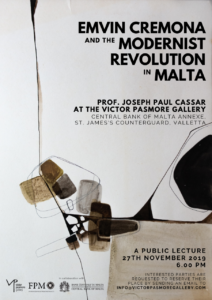This research study presents the hypothesis and then proves it, that it is not entirely true that the birth of a modern aesthetic in Malta was brought through landscape painting, or portraits, still-lifes or even abstract art, but by a strong focus on religious themes. Even though the majority of Maltese artists complained that their modern expressions never made it into churches, however an analysis of their output and list of exhibits that they were showing had a strong bias on sacred and religious themes. This was done with the intention of convincing the ecclesiastical authorities to gradually develop a taste for the modern.
The analysis of this history starts with the Sacred Art Exhibition held at the Malta Society of Arts, Manufacturers and Commerce in 1945, as well as in the series of Sacred Art Biennials held at St John’s Annex in Valletta starting in 1968. The study brings to light a critical analysis of several works by key Maltese artists that include: Josef Kalleya, Anton Inglott, Giorgio Preca, Carmelo Mangion, Gabriel Caruana, Emvin Cremona, Joseph M. Genuis, George Borg, Joseph Briffa, Vincent Apap, Willie Apap, Antoine Camilleri, Frank Portelli, George Fenech, Edward Pirotta, Victor Diacono, Joseph F. Muscat, Ganni Bonnici, Samuel Bugeja, Frans Galea, Caesar Attard, Luciano Micallef among others.
The study also contains a section which offers reviews on key church documents on Sacred Art. Part of these findings were presented in a public lecture at the Victor Pasmore Gallery entitled: Emvin Cremona and the Modernist Revolution in Malta, on 27th November, 2019.

